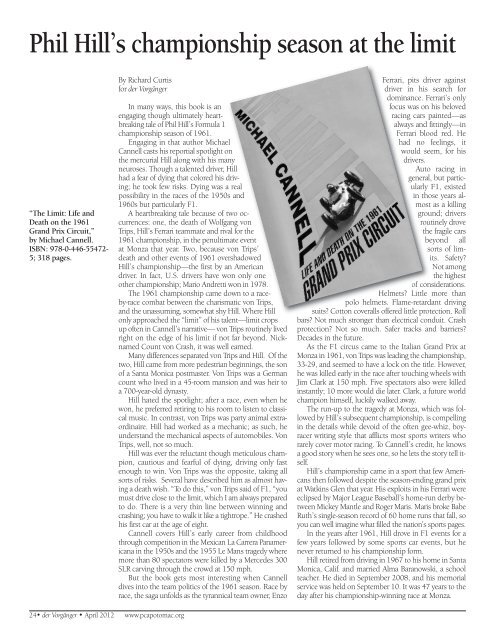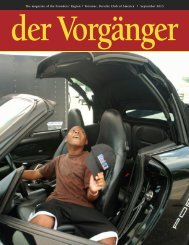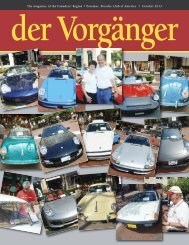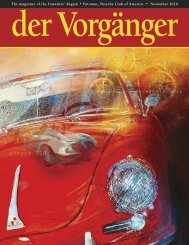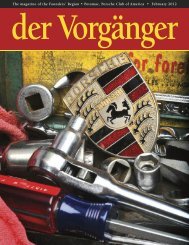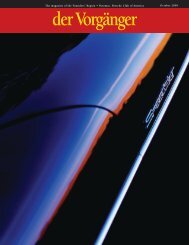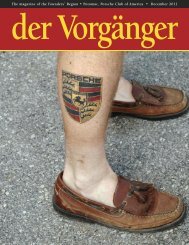Create successful ePaper yourself
Turn your PDF publications into a flip-book with our unique Google optimized e-Paper software.
Phil Hill’s championship season at the limit<br />
“The Limit: Life and<br />
Death on the 1961<br />
Grand Prix Circuit,”<br />
by Michael Cannell.<br />
ISBN: 978-0-446-55472-<br />
5; 318 pages.<br />
By Richard Curtis<br />
for der Vorgänger<br />
24• der Vorgänger • <strong>April</strong> 2012 www.pcapotomac.org<br />
In many ways, this book is an<br />
engaging though ultimately heartbreaking<br />
tale <strong>of</strong> Phil Hill’s Formula 1<br />
championship season <strong>of</strong> 1961.<br />
Engaging in that author Michael<br />
Cannell casts his reportial spotlight on<br />
the mercurial Hill along with his many<br />
neuroses. Though a talented driver, Hill<br />
had a fear <strong>of</strong> dying that colored his driving;<br />
he took few risks. Dying was a real<br />
possibility in the races <strong>of</strong> the 1950s and<br />
1960s but particularly F1.<br />
A heartbreaking tale because <strong>of</strong> two occurrences:<br />
one, the death <strong>of</strong> Wolfgang von<br />
Trips, Hill’s Ferrari teammate and rival for the<br />
1961 championship, in the penultimate event<br />
at Monza that year. Two, because von Trips’<br />
death and other events <strong>of</strong> 1961 overshadowed<br />
Hill’s championship—the first by an <strong>America</strong>n<br />
driver. In fact, U.S. drivers have won only one<br />
other championship; Mario Andretti won in 1978.<br />
The 1961 championship came down to a raceby-race<br />
combat between the charismatic von Trips,<br />
and the unassuming, somewhat shy Hill. Where Hill<br />
only approached the “limit” <strong>of</strong> his talent—limit crops<br />
up <strong>of</strong>ten in Cannell’s narrative— von Trips routinely lived<br />
right on the edge <strong>of</strong> his limit if not far beyond. Nicknamed<br />
Count von Crash, it was well earned.<br />
Many differences separated von Trips and Hill. Of the<br />
two, Hill came from more pedestrian beginnings, the son<br />
<strong>of</strong> a Santa Monica postmaster. Von Trips was a German<br />
count who lived in a 45-room mansion and was heir to<br />
a 700-year-old dynasty.<br />
Hill hated the spotlight; after a race, even when he<br />
won, he preferred retiring to his room to listen to classical<br />
music. In contrast, von Trips was party animal extraordinaire.<br />
Hill had worked as a mechanic; as such, he<br />
understand the mechanical aspects <strong>of</strong> automobiles. Von<br />
Trips, well, not so much.<br />
Hill was ever the reluctant though meticulous champion,<br />
cautious and fearful <strong>of</strong> dying, driving only fast<br />
enough to win. Von Trips was the opposite, taking all<br />
sorts <strong>of</strong> risks. Several have described him as almost having<br />
a death wish. “To do this,” von Trips said <strong>of</strong> F1, “you<br />
must drive close to the limit, which I am always prepared<br />
to do. There is a very thin line between winning and<br />
crashing; you have to walk it like a tightrope.” He crashed<br />
his first car at the age <strong>of</strong> eight.<br />
Cannell covers Hill’s early career from childhood<br />
through competition in the Mexican La Carrera Panamericana<br />
in the 1950s and the 1955 Le Mans tragedy where<br />
more than 80 spectators were killed by a Mercedes 300<br />
SLR carving through the crowd at 150 mph.<br />
But the book gets most interesting when Cannell<br />
dives into the team politics <strong>of</strong> the 1961 season. Race by<br />
race, the saga unfolds as the tyrannical team owner, Enzo<br />
Ferrari, pits driver against<br />
driver in his search for<br />
dominance. Ferrari’s only<br />
focus was on his beloved<br />
racing cars painted—as<br />
always and fittingly—in<br />
Ferrari blood red. He<br />
had no feelings, it<br />
would seem, for his<br />
drivers.<br />
Auto racing in<br />
general, but particularly<br />
F1, existed<br />
in those years almost<br />
as a killing<br />
ground; drivers<br />
routinely drove<br />
the fragile cars<br />
beyond all<br />
sorts <strong>of</strong> limits.<br />
Safety?<br />
Not among<br />
the highest<br />
<strong>of</strong> considerations.<br />
Helmets? Little more than<br />
polo helmets. Flame-retardant driving<br />
suits? Cotton coveralls <strong>of</strong>fered little protection. Roll<br />
bars? Not much stronger than electrical conduit. Crash<br />
protection? Not so much. Safer tracks and barriers?<br />
Decades in the future.<br />
As the F1 circus came to the Italian Grand Prix at<br />
Monza in 1961, von Trips was leading the championship,<br />
33-29, and seemed to have a lock on the title. However,<br />
he was killed early in the race after touching wheels with<br />
Jim Clark at 150 mph. Five spectators also were killed<br />
instantly; 10 more would die later. Clark, a future world<br />
champion himself, luckily walked away.<br />
The run-up to the tragedy at Monza, which was followed<br />
by Hill’s subsequent championship, is compelling<br />
in the details while devoid <strong>of</strong> the <strong>of</strong>ten gee-whiz, boyracer<br />
writing style that afflicts most sports writers who<br />
rarely cover motor racing. To Cannell’s credit, he knows<br />
a good story when he sees one, so he lets the story tell itself.<br />
Hill’s championship came in a sport that few <strong>America</strong>ns<br />
then followed despite the season-ending grand prix<br />
at Watkins Glen that year. His exploits in his Ferrari were<br />
eclipsed by Major League Baseball’s home-run derby between<br />
Mickey Mantle and Roger Maris. Maris broke Babe<br />
Ruth’s single-season record <strong>of</strong> 60 home runs that fall, so<br />
you can well imagine what filled the nation’s sports pages.<br />
In the years after 1961, Hill drove in F1 events for a<br />
few years followed by some sports car events, but he<br />
never returned to his championship form.<br />
Hill retired from driving in 1967 to his home in Santa<br />
Monica, Calif. and married Alma Baranowski, a school<br />
teacher. He died in September 2008, and his memorial<br />
service was held on September 10. It was 47 years to the<br />
day after his championship-winning race at Monza.


